Front Brake Rotor Replacement 1500 Series
Tools Required
Caution: Refer to Brake Dust Caution in the Preface section.
Removal Procedure
Notice: Any new rotor must have the protective coating removed from the friction surfaces before being placed in service. Remove the protective coating using
denatured alcohol or an equivalent brake cleaner, and wipe the surface clean with clean cloths. Do not use gasoline, kerosene, or other oil base solvents which may leave an oily residue. This residue is damaging to the brake lining and is flammable.

- Inspect the fluid level in the brake master cylinder reservoir.
- If the fluid level is midway between the maximum-full point, and the minimum allowable level, no fluid needs to be removed from the reservoir before proceeding.
- If the fluid level is higher than midway between the maximum-full point, and the minimum allowable level, remove fluid to the midway point before proceeding.
- Remove the tire and wheel assembly. Refer to
Tire and Wheel Removal and Installation
.
- Mark the relationship of the rotor to the hub.
- Compress the brake caliper pistons.
| 6.1. | Install 2 large C-clamps over the top of the caliper housing and against the back of the outboard pad. |
| 6.2. | Slowly tighten the C-clamps until the pistons are pushed completely into the caliper bores. |
| 6.3. | Remove the C-clamps from the caliper. |
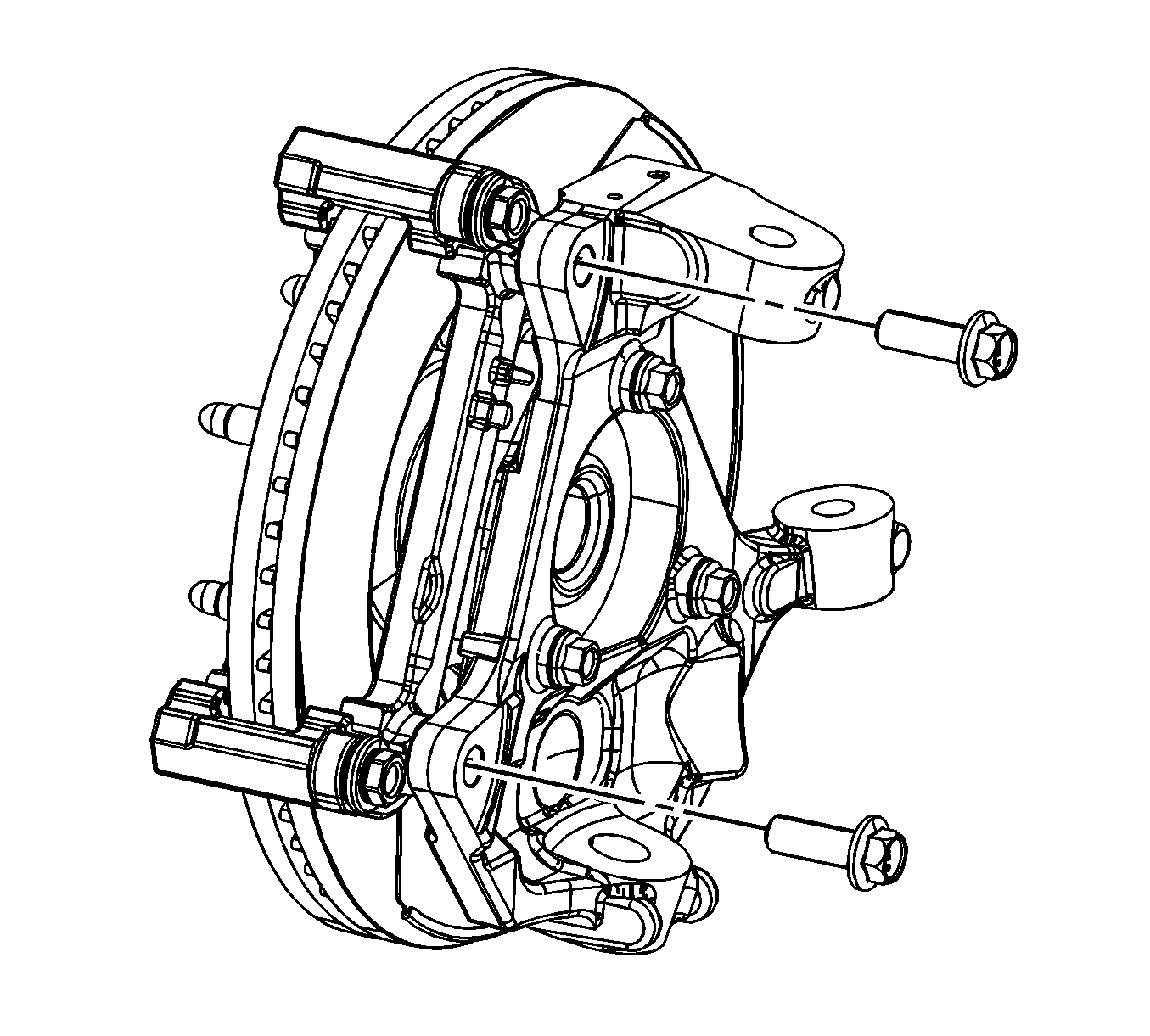
- Remove the brake caliper bracket bolts.
Notice: Refer to Brake Caliper Notice in the Preface section.
- Remove the caliper and caliper bracket as an assembly.
Support the caliper assembly with heavy mechanic's wire or equivalent. DO NOT disconnect the hydraulic brake flexible hose from the caliper.
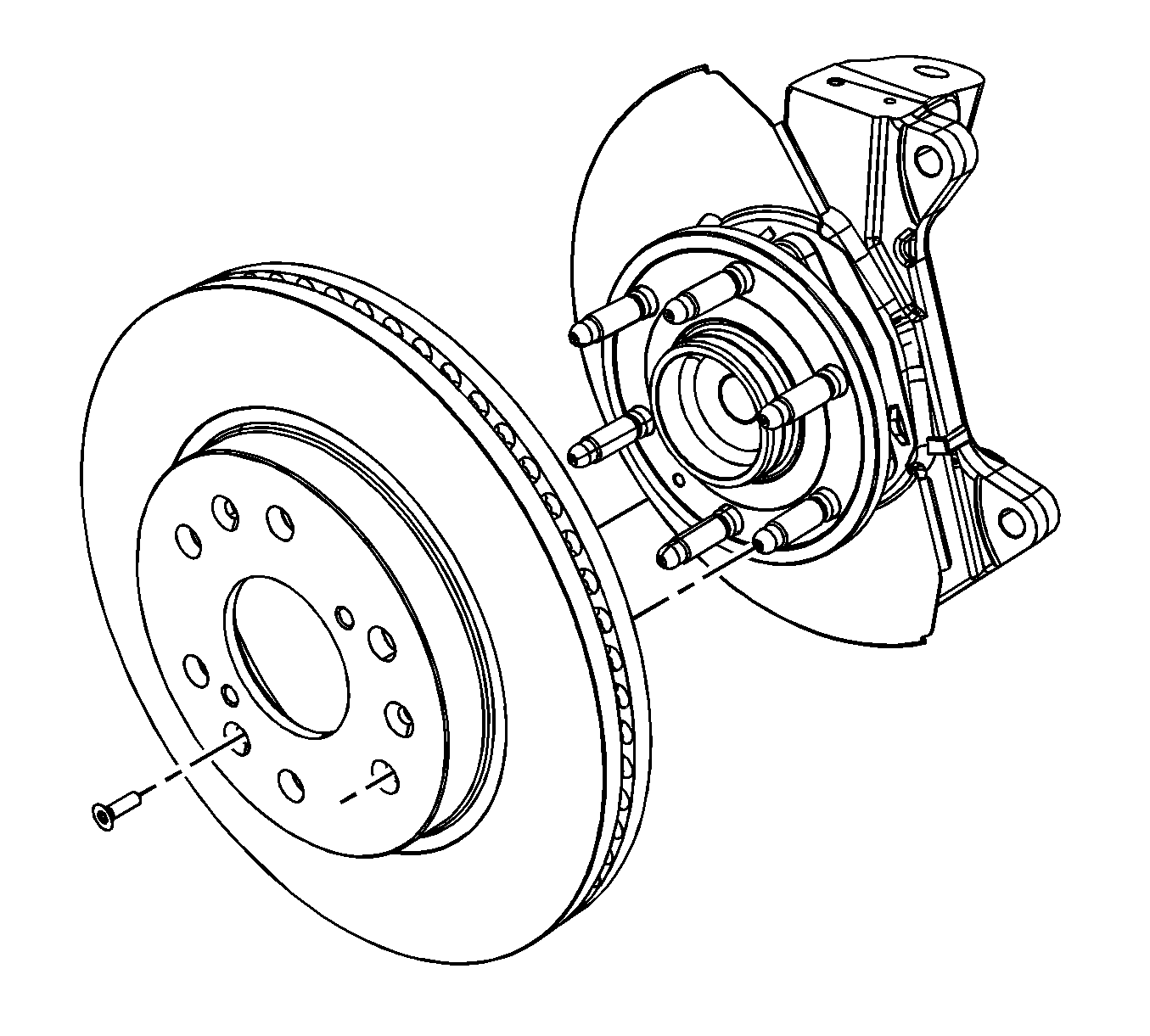
- Remove the brake rotor retaining push nuts from the wheel studs, if necessary.
- Remove the brake rotor screw.
- It may be necessary to strike the end of the hub or the rotor with a deadblow hammer to separate the rotor from the hub.
- Remove the rotor.
Installation Procedure
Important: Whenever the brake rotor has been separated from the hub/axle flange, any rust or contaminants should be cleaned from the hub/axle flange and the brake rotor mating surfaces. Failure to do this may result in excessive
assembled lateral runout (LRO) of the brake rotor, which could lead to brake pulsation.
- Use the
J 42450-A
to clean all rust and contaminants from the mating surface of the hub flange.
- Use the
J 41013
to clean all rust and contaminants from the inside diameter of the hat section of the brake rotor to prevent any foreign material from getting between the brake rotor and the hub
flange.
- Inspect the mating surfaces of the hub/axle flange and the rotor to ensure that there are no foreign particles or debris remaining.
Important: If the rotor was removed using the jack screw method you must ensure that the hub flange is free of nicks or marks caused by this procedure. Remove all raised nicks or marks before installing the rotor.

- Align the rotor to its original position on the hub (if applicable) and install
the rotor.
Notice: Refer to Fastener Notice in the Preface section.
- Install the brake rotor screw.
Tighten
Tighten the screw to 12 N·m (106 lb in).
- If the rotor was removed and installed as part of a brake system repair, measure the assembled lateral runout (LRO) of the rotor to ensure optimum performance of the disc brakes. Refer to
Brake Rotor Assembled Lateral Runout Measurement
.
- If the rotor assembled LRO measurement exceeds the specification, bring the LRO to within specifications. Refer to
Brake Rotor Assembled Lateral Runout Correction
.

- Install the caliper and caliper bracket as a assembly.
- Perform the following procedure before installing the caliper bracket bolts.
| 9.1. | Remove all traces of the original adhesive patch. |
| 9.2. | Clean the threads of the bolt with brake parts cleaner or the equivalent and allow to dry. |
| 9.3. | Apply Threadlocker GM P/N 12345493 (Canadian P/N 10953488) to the threads of the bolt. |
- Install the brake caliper bracket bolts.
Tighten
Tighten the bolts to 180 N·m (133 lb ft).
- Install the tire and wheel assembly. Refer to
Tire and Wheel Removal and Installation
.
- Lower the vehicle.
- With the engine OFF, gradually apply the brake pedal to approximately 2/3 of its travel distance.
- Slowly release the brake pedal.
- Wait 15 seconds, then repeat steps 13-14 until a firm pedal is obtained. This will properly seat the caliper pistons and pads.
- Fill the master cylinder reservoir to the proper level with clean brake fluid, if necessary. Refer to
Master Cylinder Reservoir Filling
.
Front Brake Rotor Replacement 25/3500 Series
Tools Required
Caution: Refer to Brake Dust Caution in the Preface section.
Removal Procedure
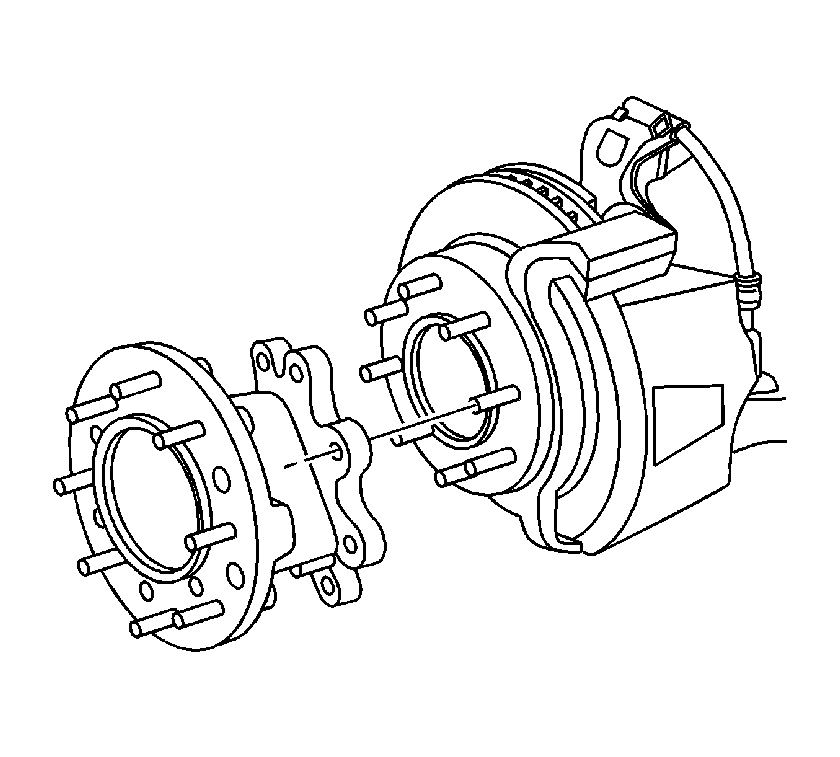
Notice: Any new rotor must have the protective coating removed from the friction surfaces before being placed in service. Remove the protective coating using
denatured alcohol or an equivalent brake cleaner, and wipe the surface clean with clean cloths. Do not use gasoline, kerosene, or other oil base solvents which may leave an oily residue. This residue is damaging to the brake lining and is flammable.
- Remove the tire and wheel assembly. Refer to
Tire and Wheel Removal and Installation
.
- Remove the front wheel hub extension, dual wheel vehicles only.
| 2.1. | Insert a drift or large screwdriver through the brake caliper into one of the brake rotor vanes in order to prevent the rotor from turning. |
| 2.2. | Mark the relationship of the front wheel hub extension to the hub. |
| 2.3. | Remove the front wheel hub extension nuts. |
| 2.4. | Remove the front wheel hub extension from the vehicle. It may be necessary to tap around the perimeter of the hub extension with a rubber mallet to loosen it from the hub. |

- Inspect the fluid level in the brake master cylinder reservoir.
- If the fluid level is midway between the maximum-full point, and the minimum allowable level, no fluid needs to be removed from the reservoir before proceeding.
- If the fluid level is higher than midway between the maximum-full point, and the minimum allowable level, remove fluid to the midway point before proceeding.
- Mark the relationship of the rotor to the hub.
- Compress the brake caliper pistons.
| 7.1. | Install 2 large C-clamps over the top of the caliper housing and against the back of the outboard pad. |
| 7.2. | Slowly tighten the C-clamps until the pistons are pushed completely into the caliper bores. |
| 7.3. | Remove the C-clamps from the caliper. |
Notice: Refer to Brake Caliper Notice in the Preface section.
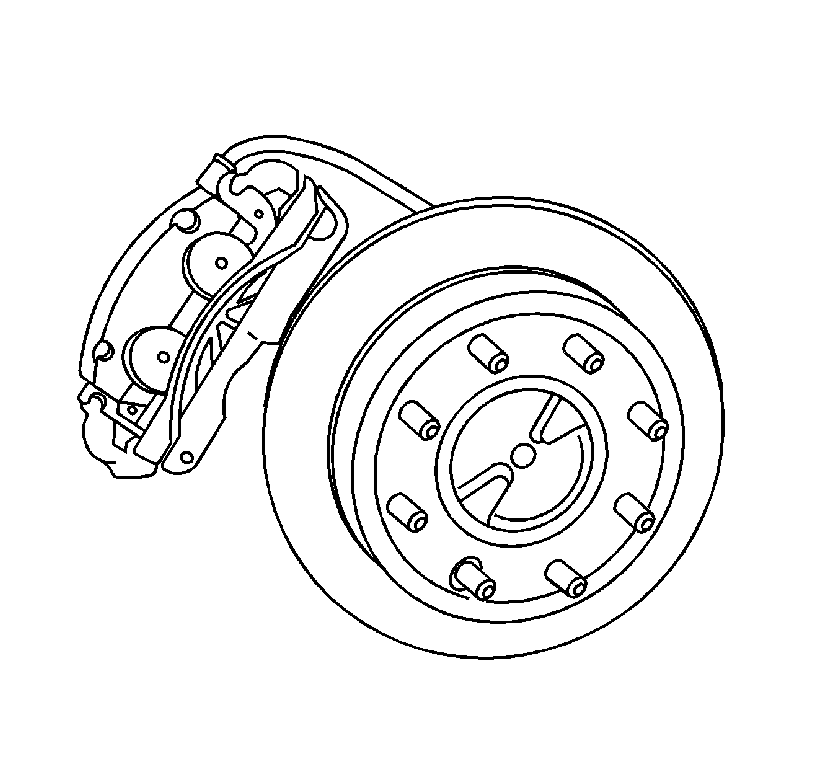
- Remove the caliper and caliper bracket as an assembly.
Support the caliper assembly with heavy mechanic's wire or equivalent. DO NOT disconnect the hydraulic brake flexible hose from the caliper.
- Remove the brake rotor retaining push nuts from the wheel studs, if applicable.
- It may be necessary to strike the end of the hub or the rotor with a deadblow hammer to separate the rotor from the hub.
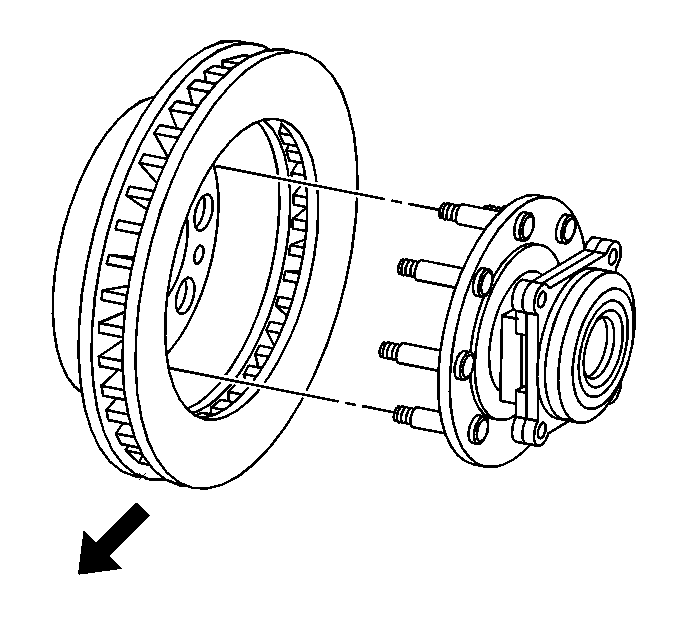
- Remove the brake rotor.
- If the rotor is difficult to remove due to corrosion in the hub area use the following procedure to remove the rotor.
| 12.1. | Clean all the surface areas and the threaded holes of contamination. |
| 12.2. | Generously apply penetrating oil or the equivalent to the hub/rotor area. |
| 12.3. | Insert two M10 x 1.5 bolts or jack screws into the threaded holes of the rotor. |
| 12.4. | Tighten both bolts evenly to force the rotor from the hub. |
Installation Procedure
Important: Whenever the brake rotor has been separated from the hub/axle flange, any rust or contaminants should be cleaned from the hub/axle flange and the brake rotor mating surfaces. Failure to do this may result in excessive
assembled lateral runout (LRO) of the brake rotor, which could lead to brake pulsation.
- Use the
J 42450-A
to clean all rust and contaminants from the mating surface of the hub flange.
- Use the
J 41013
to clean all rust and contaminants from the inside diameter of the hat section of the brake rotor to prevent any foreign material from getting between the brake rotor and the hub
flange.
- Inspect the mating surfaces of the hub/axle flange and the rotor to ensure that there are no foreign particles or debris remaining.
Important: If the rotor was removed using the jack screw method you must ensure that the hub flange is free of nicks or marks caused by this procedure. Remove all raised nicks or marks before installing the rotor.

- Align the rotor to its original position on the hub (if applicable) and install the rotor.
- If the rotor was removed and installed as part of a brake system repair, measure the assembled lateral runout (LRO) of the rotor to ensure optimum performance of the disc brakes. Refer to
Brake Rotor Assembled Lateral Runout Measurement
.
- If the rotor assembled LRO measurement exceeds the specification, bring the LRO to within specifications. Refer to
Brake Rotor Assembled Lateral Runout Correction
.

- Install the caliper and caliper bracket as an assembly.
- Perform the following procedure before installing the caliper bracket bolts.
| 8.1. | Remove all traces of the original adhesive patch. |
| 8.2. | Clean the threads of the bolt with brake parts cleaner or the equivalent and allow to dry. |
| 8.3. | Apply Threadlocker GM P/N 12345493 (Canadian P/N 10953488) to the threads of the bolt. |
Notice: Refer to Fastener Notice in the Preface section.
- Install the brake caliper bracket bolts.
Tighten
Tighten the bolts to 300 N·m (221 lb ft).

- Install the front wheel hub extension (dual wheel vehicles only).
| 10.1. | Insert a drift or large screwdriver through the brake caliper into one of the brake rotor vanes in order to prevent the rotor from turning. |
| 10.2. | Align and install the front wheel hub extension to the original position on the hub. |
| 10.3. | Install the front wheel hub extension nuts. |
Tighten
Tighten the nuts to 130 N·m (96 lb ft).
- Install the tire and wheel assembly. Refer to
Tire and Wheel Removal and Installation
.
- With the engine OFF, gradually apply the brake pedal to approximately 2/3 of its travel distance.
- Slowly release the brake pedal.
- Wait 15 seconds, then repeat steps 13-14 until a firm pedal is obtained. This will properly seat the caliper pistons and pads.
- Fill the master cylinder reservoir to the proper level with clean brake fluid, if necessary. Refer to
Master Cylinder Reservoir Filling
.












